Moldy Sourdough Starter [with photos of bad sourdough starter]
This post may contain affiliate links.
A moldy sourdough starter can be the stuff of nightmares - all your hard work gone.
But what can you do to save a moldy sourdough starter? And how can you prevent mold on your sourdough starter in the future?
There are so many opinions when it comes to mold on sourdough starter. But ultimately it comes down to safety - the safety of yourself and your family.
You don't want to put yourself or anyone else at risk.
So knowing how to recognise mold on your sourdough starter and knowing what to do it if does appear is really important.
What Is Mold?
Mold is a fungus. It has thread like filaments called hyphae which can thread all the way through your starter, even if the mold only looks like it's on the surface.
Mold is not a bacteria. It is made up of more than one cell. And in fact, the thread like filaments actually form a mycelium which is defined as a single organism.
When developed on food (like sourdough starter) mold has a discolored and fuzzy appearance.
One of the defining factors of mold is the fuzz.
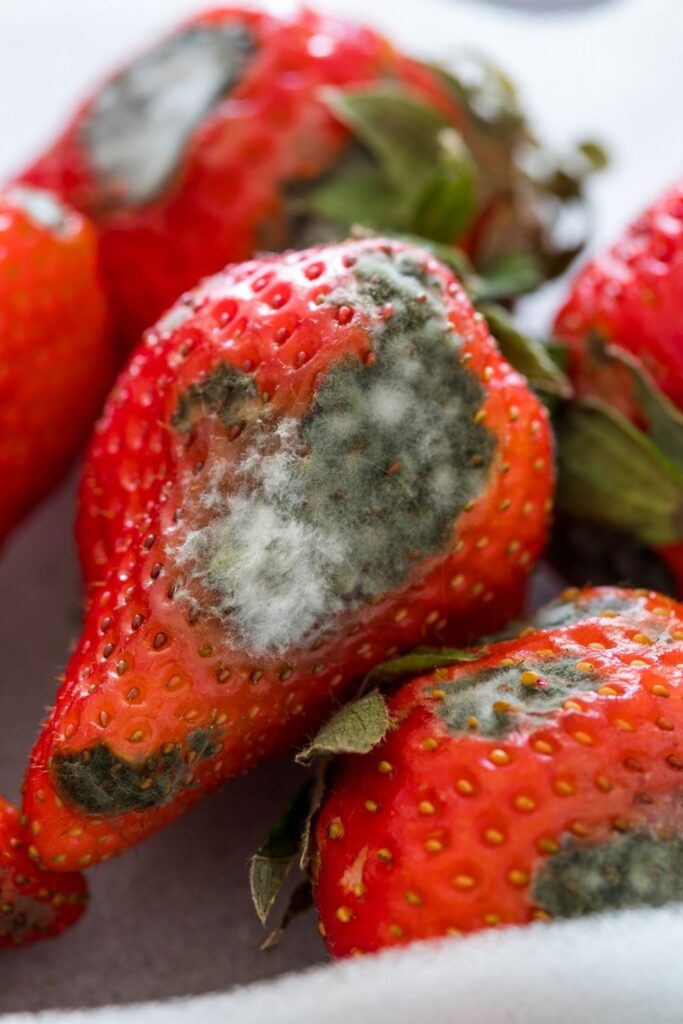
What If My Sourdough Starter Has Mold?
Unfortunately, if you discover mold on your sourdough starter you will need to toss it out.
There is no coming back from mold, no matter what anyone might tell you.
Mold may only appear on the top of your starter, however the spores will be right throughout your starter.
Some people say that you can just scrape the mold off but this is not advisable.
If you see any kind of mold, throw the starter away.
For this reason, you should always have a back up of your sourdough starter - whether you have a jar in the fridge or a dehydrated starter just in case.
If your new starter (less than a few weeks) has gone moldy, it's not a big deal to start again using these instructions.
Alternatively, you could decide to purchase a ready made sourdough starter.
Can Bad Sourdough Starter Make You Sick?
Absolutely! Using moldy sourdough starter is a recipe for disaster.
If there's even a tiny bit of mold on your sourdough starter, you need to toss it.
It cannot be saved and you should not use it.
Consuming mold can cause many illnesses including respiratory illnesses. You don't want to mess with mold!
Obviously you wouldn't consume raw, moldy sourdough starter. But even baking with moldy or bad sourdough starter can make you very sick.
Why Does Mold Occur on Sourdough Starter?
Mold can occur on sourdough starter for a number of reasons.
The trick is that you need to develop the good bacteria - which are quite resistant to mold. The more mature your sourdough starter is, the less likely it is to develop mold (unless you subject it to harsh neglect).
It can occur for a number of reasons including:
- it has come from the flour you're using
- you haven't fed your starter regularly enough or given it enough food so the "good" bacteria hasn't formed fast enough to prevent the mold.
- you've neglected your sourdough starter and left it unfed for a long period of time
- the jar or container, stirrer etc used to make or mix the starter is contaminated.
Is It Mold or Is It Hooch?
Many people confuse mold on a sourdough starter with hooch. It really can be a bit confusing and sometimes they can look very similar.
Sourdough starter that is stored in the fridge for a long time can develop a very dark colored hooch that is often mistaken for mold.
Similarly, if left on the counter, some starters can develop darker patches that may look like mold forming. It is actually the very beginnings of hooch.
Oxidation of your starter can also look like mold but is just discoloration caused by exposure to air.
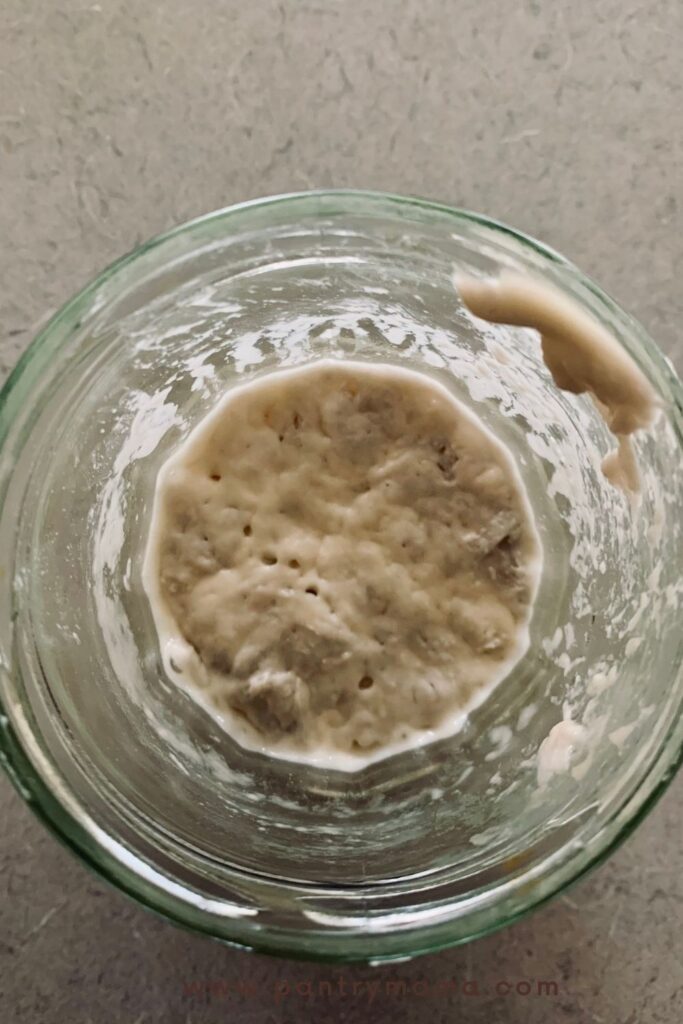
It can be hard to tell the difference between the two if you're not familiar with what to look out for.
If it's mold, it will generally be fuzzy (whether it's green, black or white).
Hooch on the other hand will be liquid or look like a shadow or stain. Hooch (and oxidization)is never fuzzy.
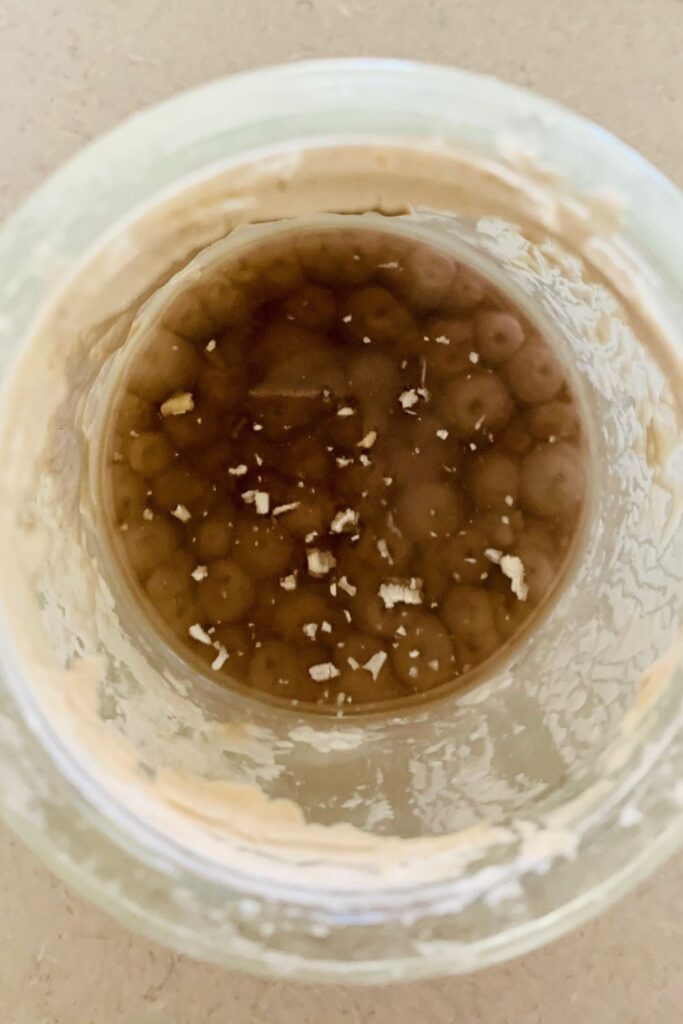
How To Prevent Mold Occurring In A Starter
In some cases, mold is caused by bacteria in the flour you are using. In other cases, it's due to neglect, under feeding or not having good kitchen hygiene.
In any case, here's how to prevent mold in your sourdough starter:
- Change Your Flour
Sometimes your flour can contain contaminants out of your control. If your sourdough starter has developed mold, it's a really good idea to change the flour you're using. Open a fresh bag and try again. - Feed Your Starter Regularly
Be sure not to neglect your sourdough starter.
If it's on your counter, it needs to be fed twice a day during the establishment phase. You can feed it less once it's mature, however it's very important to keep an eye on it for any signs of deterioration. - Weigh Your Ingredients
It's really important to weigh your ingredients rather than measure using cups (volume).
Weighing the flour and water for your sourdough starter ensures that the microbiome is adequately fed and will help the good bacteria to defend against any unwanted pathogens. - Clean Everything Thoroughly
Ensuring the jar you make your sourdough starter in is thoroughly cleaned, as well as any implements you use to measure or stir.
Practicing good kitchen hygiene will assist in preventing mold from forming in your starter.
Is Mold Different To Kahm Yeast?
Yes, mold is different to Kahm Yeast.
Kahm yeast is often mistaken for mold, however it is quite different. It isn't actually mold, but instead a free range yeast. It can look like a foamy or powdery white film on your sourdough starter.
It is possible for Kahm Yeast to float on top of hooch.
While it is not desirable in a sourdough starter, unlike mold, a starter affected by Kahm Yeast can be saved. It will give your starter an unpleasant aroma.
If your sourdough starter is affected by Kahm Yeast, you should follow these steps to totally refresh your starter.
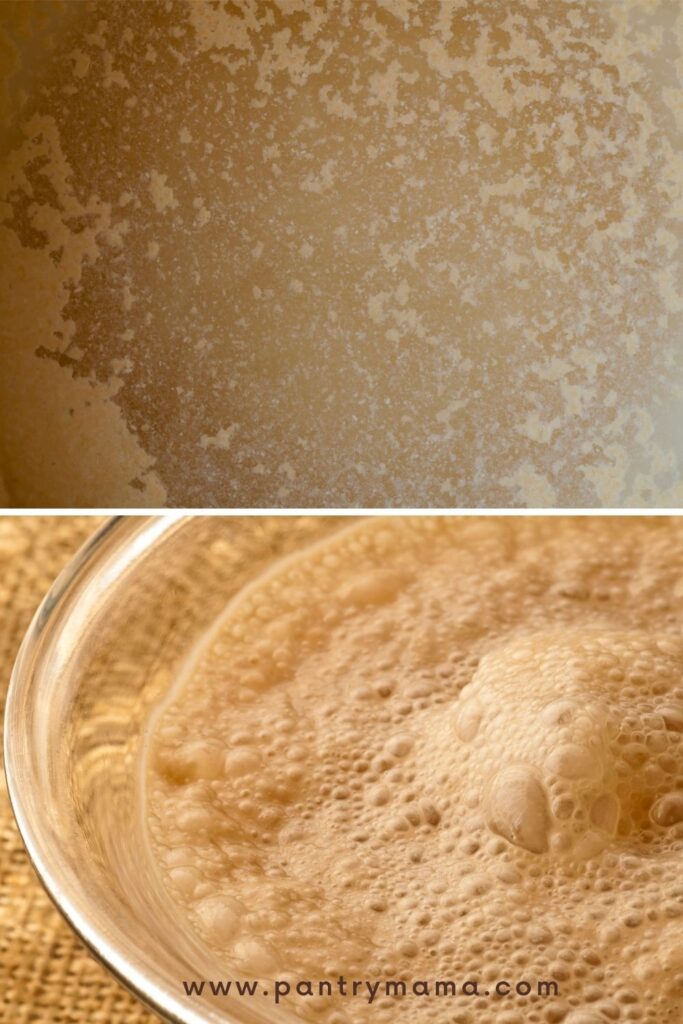
What If There's Pink Streaks In My Sourdough Starter?
Pink or orange streaks in your starter are never a good thing. If your starter develops pink or orange streaks or a film, it must be thrown away.
They may be very faint, but if you are unsure, it's better to be safe than sorry with this one.
The pink streaks are actually not caused by mold, but by a harmful bacteria called Serratia marcescens.
This bacteria is harmful to humans and can cause many illnesses.
Just a caveat to this - sometimes rye flour can cause a slight pink tinge to your sourdough starter. This is very different to the streaks caused by serratia marcescens.
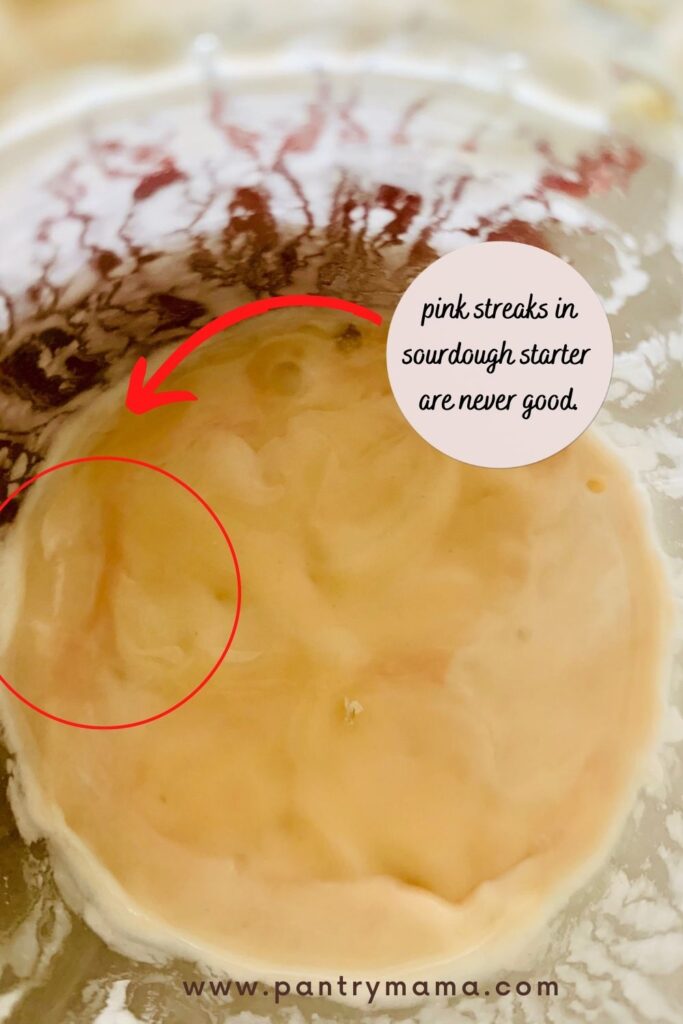
Further Reading
If you found this article about moldy sourdough starters helpful, you might enjoy these:
- Learn how to prevent mold in sourdough bannetons.
- Boost your sourdough starter to make sure it's resilient to mold.

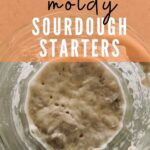
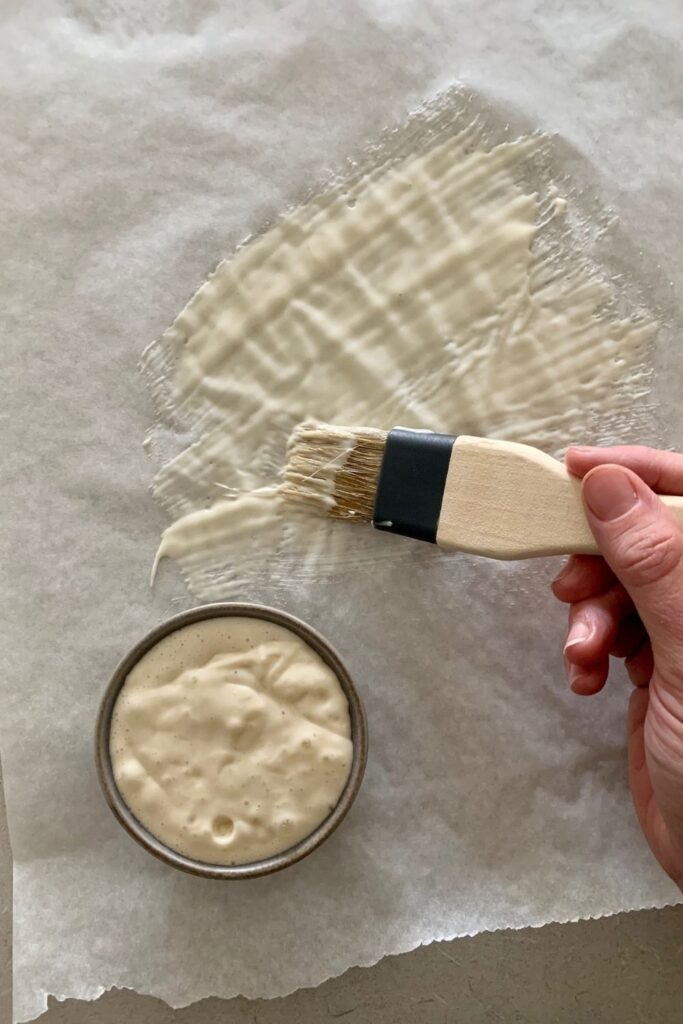
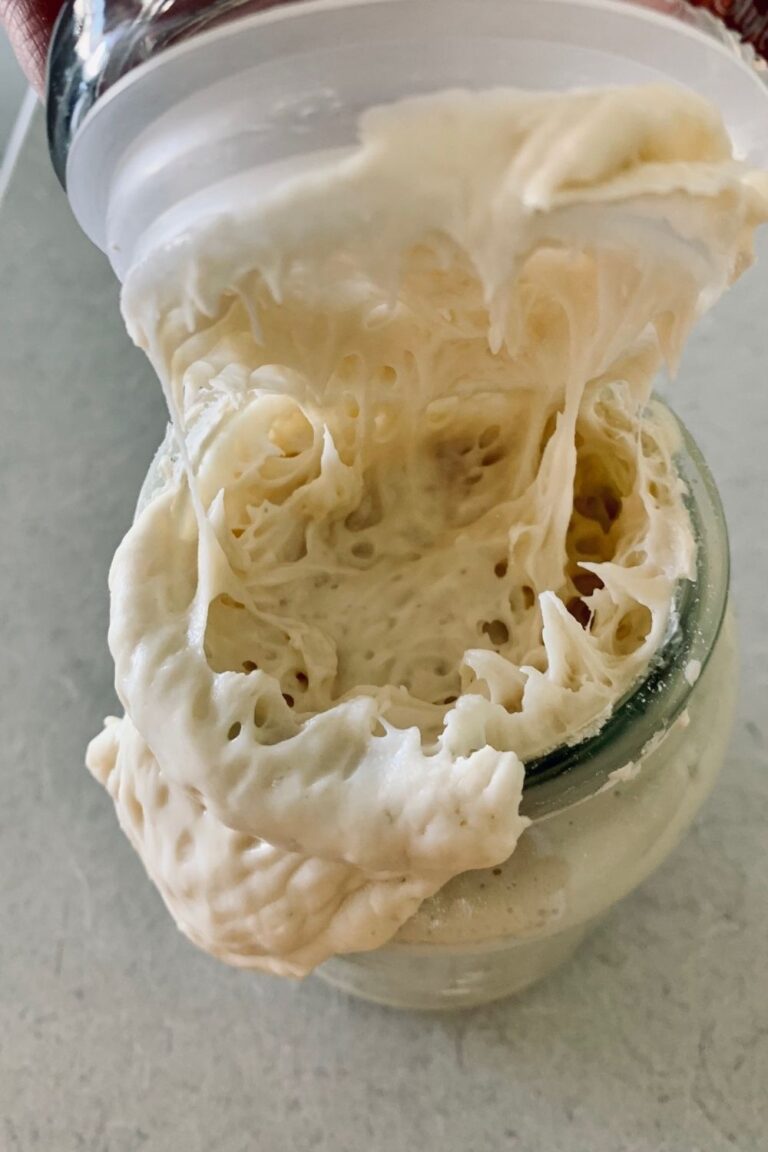
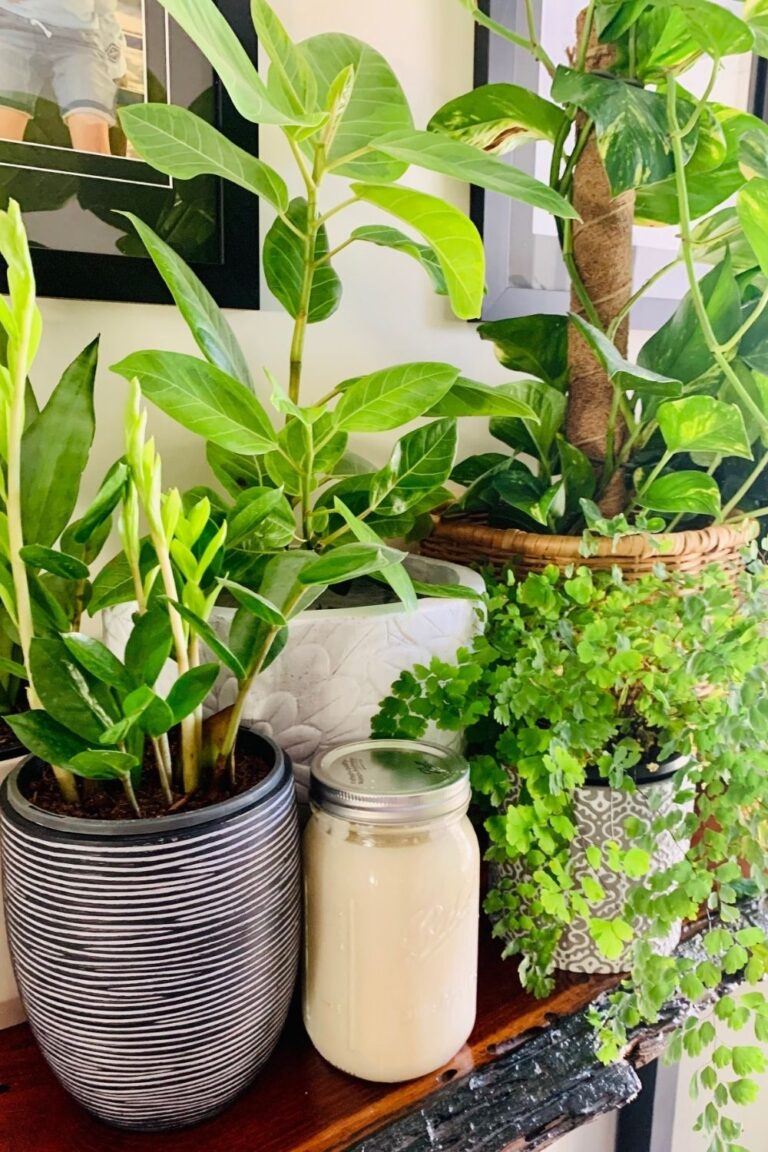
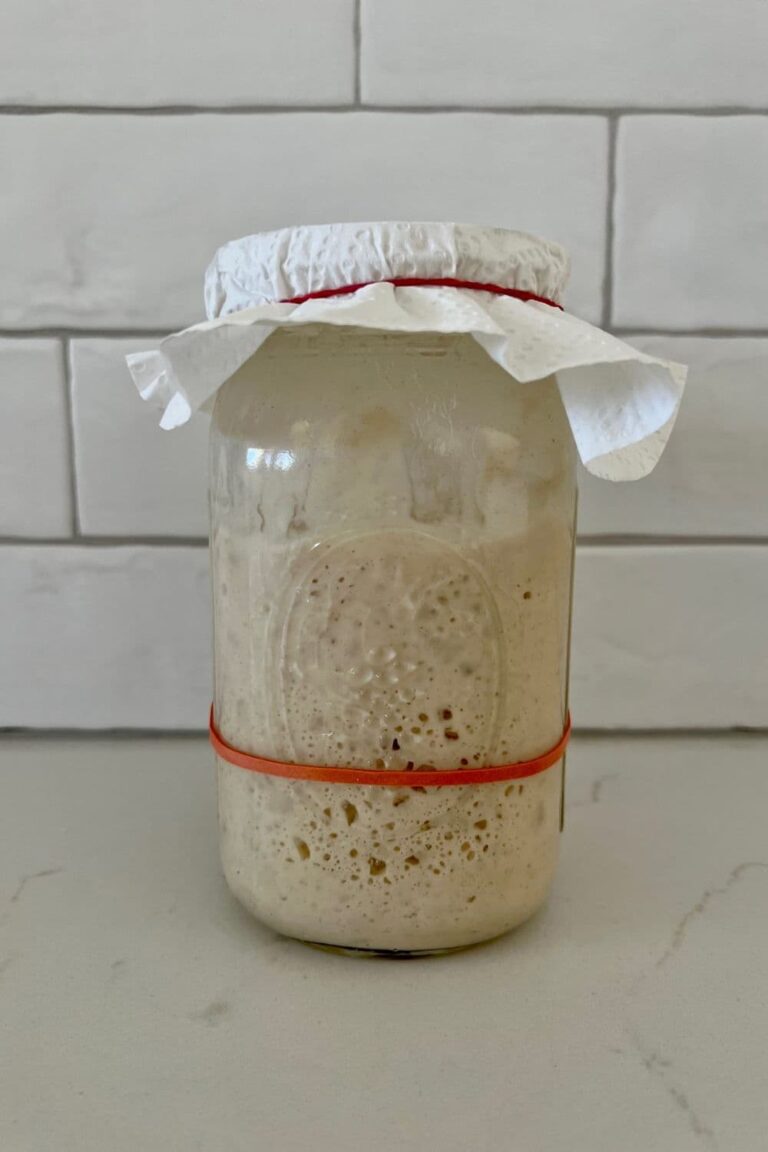
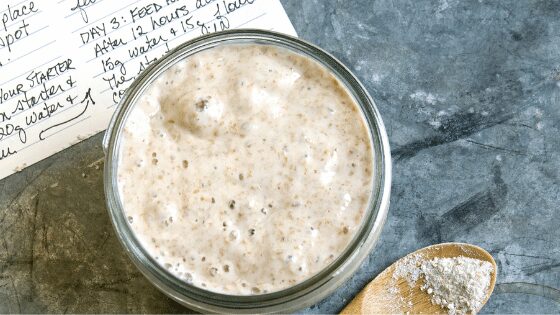
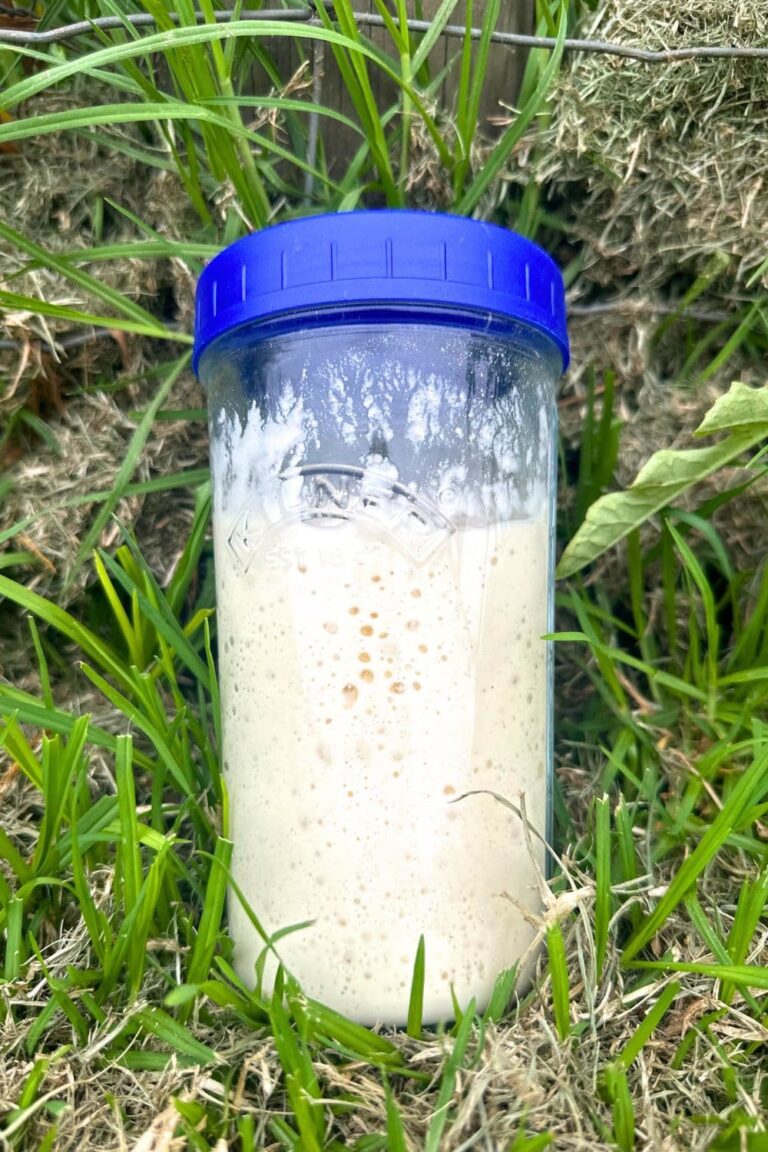
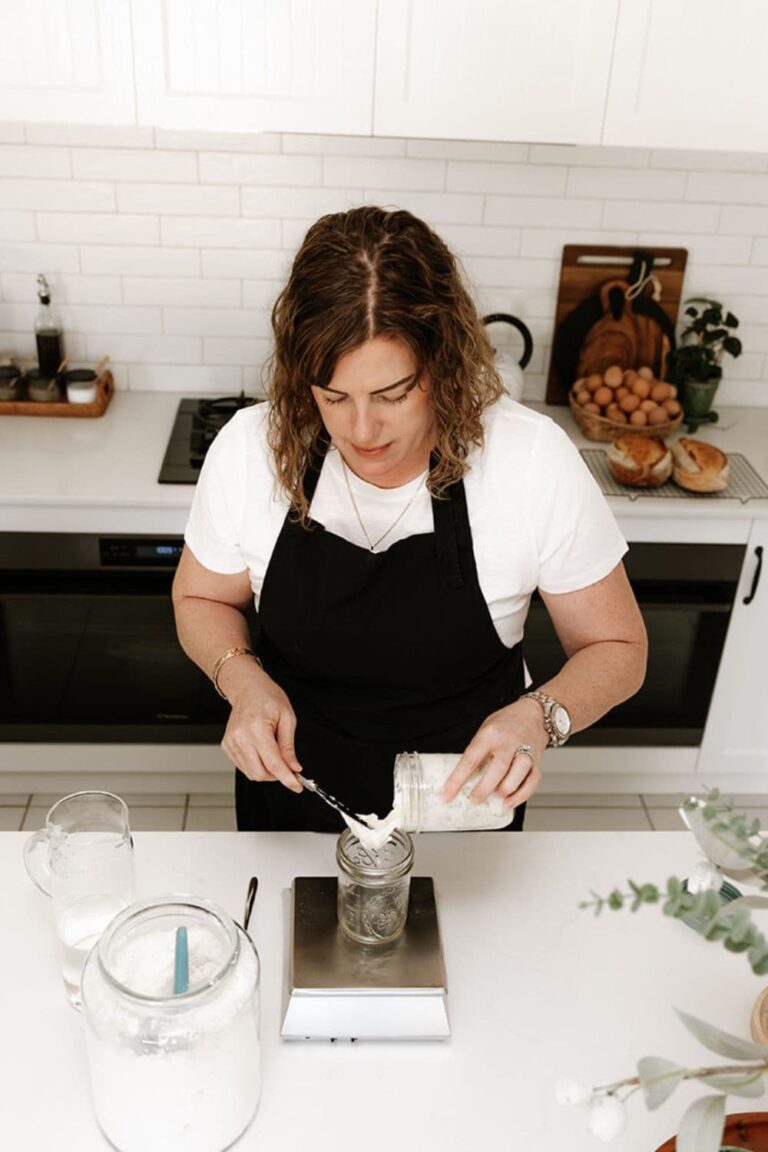

During a kitchen remodel, I stored my starter in the coldest part of the frig. Have not opened it or fed it for 3 months. It developed a light grey color at the very top of the starter, about 1/16 of an inch. The rest is fine. It's not fuzzy and It doesn't smell bad. Should I throw it away? Or just scrape the top off?
Thanks
Does moldy starter bubbles and still alive ? Incase not recognizing weather its mold or hoock
Hi I am new to sourdough making and have a gf sour dough starter that I have had in my fridge for probably a few weeks to a month. I haven’t fed since I put in the fridge. It has about 2 inches of water from the top which I’m assuming is the hooch? I don’t see any mold, but there is some white dried flour crusty stuff on inside of the jar from Transferring to a different jar. If there was mold on this part could I still use it since I see none on the inside? It smells super fruity. I’m just not sure. Thanks
I desperately need some advice on what to do with my starter. The starter is now almost three years old and has sometimes been left in the fridge while we've been travelling for a few weeks, but it has always come back to life. Usually after being in the fridge though, it has had an oxidised thick crusty layer on top that I've just discarded and just moved the starter to a clean jar after that. The thick layer has usually had a cloudy/matt velvety surface, but no fuzz, discolouration, streaks or weird blotches or anything. Sometimes it's had a couple of white dry peaks on the parts that have maybe sat a little higher on the starter's surface, but they have never been fuzzy and I've always just thought it had dried out a little. I've almost always had a clean paper towel between the jar and the lid (because I thought you were supposed to let the starter breathe), but now I think that has been the reason the starter has oxidised and dried out in the fridge. I haven't baked with my starter in a while, but now I'm starting to hesitate about continuing on with it, because I can't be totally sure the velvety layer has not been mould. I've been googling it countless times but have not found anything that would have given me any indication of what to do, because none of the "mouldy starter" pictures I've seen have looked like the problem I've had. I've continued feeding it, but now I'm not totally sure it's safe to bake with. Would a mouldy starter continue to act normally, if you continued feeding it and is there a way to tell if the started is safe to use now? I've always used bread and rye flours to feed it with equal amounts of flour and water. I've since left out the paper towel and have been keeping it at room temp and feeding it daily. I haven't seen the Cloudy/velvety layer again and the starter is now rising well and it has has a nice aroma. Is it safe to use or should I keep feeding it and keep looking for any signs of that velvety layer? Is it possible that the layer was kahm yeast on a dry surface?
Yesterday I noticed white fuzz near top of sourdough starter jar. Also, looked like some green on side of jar where some starter had stuck. There was nothing on starter itself. I took small bit of starter and put into a new clean jar. So far not seeing any mold. Is this okay or do I need to start over? If it has mold will it quickly show up again? Or could it still have mold and it not show up as I have moved jars?
If my starter has the pink streaks and spots do I have to toss the container also ?
No, just the starter. If it's glass, just wash it very well. I don't recommend using plastic 🙂
Hi PantryMama,
Please i need help, i don’t know why my starter ALWAYS get this pink stuff. I always make sure everything is cleaned and esterilized (boiling water method) but still appear.. I don’t know what to do i’m so sad honestly.. Thank you.
Hi, I was wondering if I did happen to see what looked to be a slight pink streak in my sourdough starter, how could I best verify that it really is infected? As in would the streaks reappear consistently or should I let it sit out for some time since I had already fed it. Just wanted to make sure that it was a legitimate streak and not just the way the flour clumped in a particular way or if it was the light hitting it a certain way. Either way, I'll hold off making anything with it and just observe it for now.
Forgot to feed my 4 month old starter yesterday and today, there's mold..very disheartening. I've been saving my discard though, can I use it to kickstart a new starter?
I had my almost ready to bake starter in the fridge, but, due to life, it was left in there, nice tight seal, for about 2 months. I saw it, took it out ready to toss, but the Hooch smelled and looked ok, no noticeable mold. But then, I ended up feeding it and left it on my deck in direct sun, about 80 degrees out, no covering! Ugh! I brought it in, fed it, it got super active! 🤷🏼♀️ (Now this is starter from organic Sorghum flour, which I’ve done before.)
Since it was left outside, in full sun not dark, but lid covered, is it ok? Should I throw it out and start over? It’s now in my oven, dark with the light on and very active. I did change jars and put in a very clean one. 🤷🏼♀️
I fed with wheat last night and now looks pinkish. None before. Is this from the wheat flour? Very faint and unsure if truly pinkish. No streaks
I have this brown thick stuff that grows on top. I think it’s hooch. Should I throw the brown stuff away or mix it into the starter? I think usually it’s from having it in my oven over 4 hours with the light on and it dries out.
I left two starters on the counter overnight, this morning the tops had a bright green substance on them, what is it?
My sour dough starter is about 4 years old. I have refreshed it a couple of times. Seems to have been just right. The last few days, the bubbles on top as it ferments look like black dots. When I stir it up, the dots (bubbles) are gone. Is there a problem I need to deal with?
I have a thin crust on the top of my starter. No fuzz, no bad smells. Can I take the hardened part off and feed the rest/carry on? This is all so confusing sometimes!
Was rehydrating some starter and I’m on day 5. I went to feed it and know there is fuzzy mold on the side of the jar. I have fed it daily and kept it out on the counter (71F). What could have caused this? The dehydrated starter came from a very well established starter.
I have been baking sourdough for a long time. If you have mold/mushrooms or whatever invading your starter throw it away. Get a teaspoon from a friend and start from that. You will thank yourself for following this simple plan.
Hugs to all bakers, Billy
I'm using Kamut which became hard for me to come by. I ordered a huge bag from a different company than my normal spot (sold out). I'm finding mold in my starter for the first time in years. So I'm worried that I'm stuck with expensive bag of moldy flour and can't use it! How do I tell if it's from the flour or something else? I did leave it unfed for a couple days in cool house, on the counter. Sort of as a way to test the new flour. I never had issues with the other flour (I also have original starter dried to experiment more).
My starter smells like very old cheese every feed. I feed it once a day and its day 6 now. Does it mean that I need to feed it twice a day?
My second question, can I transfer my starter to another jar ? As I’m afraid that because of this smell that the jar might be contaminated from the byproducts produced from the starter ?
Thank you
I am trying to figure out what the cloudy gel is that formed on my starter.. not liquid so I’m guessing it’s not hooch. I pulled it off and rinsed it off. It feels like slime/snot, smells very sour but not rotten. Any thoughts?
I have been growing my starter for 6 weeks. Last week started to save in the fridge the discard. Now the last couple of days the started seems to be growing white mold. Can I take out of the fridge and feed the discard, instead of starting all over?
Hello--I have had a really good starter but thought I'd see if I could get it to go faster and bought rye flour. I've fed it a few times with rye and after a few days it molds with white mold while sitting on a cool counter. Is the flour contaminated maybe?
Your flour could be contaminated, yes. However, whole grain flour can be more difficult to prevent mold, so if it is molding, just stick to your all purpose flour. Try keeping your starter warmer as this will help it to bubble faster.
My sourdough starter was feed and then left on top if the fridge for a week! And it has been very warm these past few days. The starter developed a crust that was pink/purplish that once removed the rest looked and smelled fine. I transferred it to a clean jar and fed it. However, after reading your post I think it's probably best to just throw it out. I'll go revive my back up from the back of the fridge!
I’m so thankful I have found you! While a good experienced bread baker, sourdough is a new adventure. I garden and during garden season my starter got neglected badly. I am using my sourdough discard to get things going again as the starter did have fuzz and didn’t smell too good. The discard was in the fridge, top shelf way back in the back and semi frozen. No smell, just good sour smell, no fuzz so I’m boosting that. I have made crackers, brownies etc with the discard so I love having that as well as the starter.
Thank you so much for all the wonderful info! Keep that starter going!